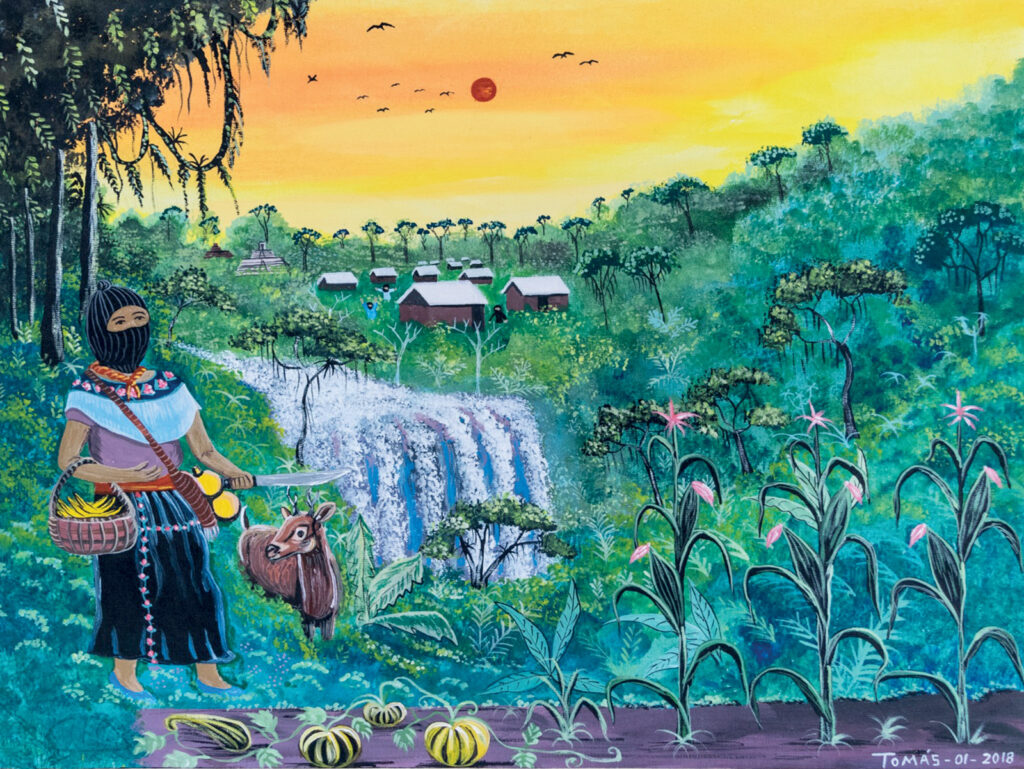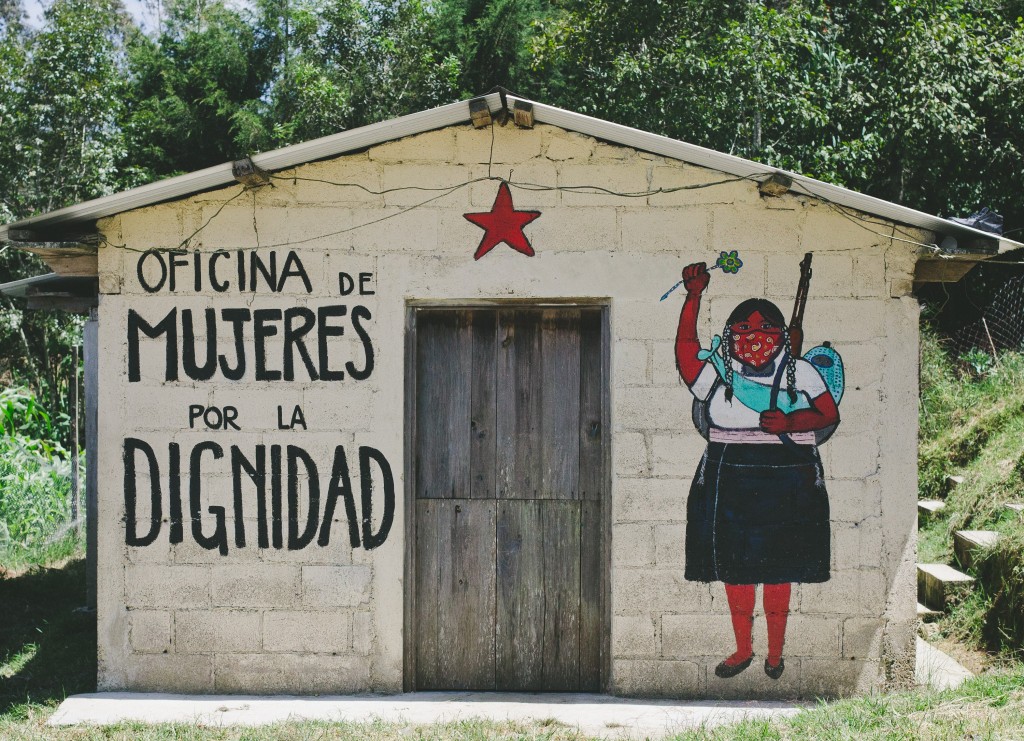Rosaluz Pérez Espinosa

I
Ana María was the first indigenous woman to join the EZLN, where rose to the ranks of major. According to her, because of their education and culture, the Zapatista women are not fighting against gender oppression only1 In the years leading up to the 1994 eruption, it did not seem to them to be a sufficient reason to take up arms. Many may have wanted to flee their fate by the cooking fire, but this is not what gave them the strength to get involved in the war and shout “enough is enough!” Rather, it was the possibility of changing their families, their community and their environment. The history of many female militants starts from this point, because for centuries, it is they who have been responsible for the reproduction, care and continuity of their communities.
At the beginning, women were in the minority, but their numbers increased after participating in meetings where they discussed their experiences and shared their points of view on both the strategy and the philosophical vision of the movement. They outlined another horizon of struggle for the EZLN, although they have not always succeeded in asserting it. They occupied relevant positions in the military command, recruited insurgents and worked in different areas. Their interests and aspirations are a foundation for the Zapatista project of autonomy. This is the story of the ever-challenging participation of women in this dream.
II
For more than a century, the plantation system defined the life of the people who would later form the EZLN. The economic basis of colonial expansion in Guatemala, the captaincy 2 to which Chiapas belonged until 1821, was the work of reproducing community life, encompassing all aspects of maintaining and recreating the community -such as the way of producing food, the making of products (for example, clothing) and social organization-. Both men and women had been responsible for the subsistence of the community, but this ceased to be the case when the colonial system imposed a new gender division on this labor, which it incorporated as servitude3.
Later, after the colonial period, the socioeconomic organization of the communities made possible the reproduction of one class in service to another 4 and the existence of places with abundant labor. The labor force, plentiful and conveniently gathered in the communities, represented a valuable and contested commodity from the independence of Mexico until the collapse of the finca system5.
The capitalist expansion of agriculture in Chiapas took advantage of the colonial systems and gave them another function6. The new order was sustained by the coffee farms and the indentured servants, whose families had to work three to four days a week to pay a part of the use of the land. This dependency created complex relationships of paternalism and domination, especially for women, who did not receive any payment for the productive, domestic and child-rearing activities they performed in the employer’s house.
By the mid-1980s, when they joined Zapatismo, most communities had emancipated themselves from bondage and were living in independent villages7, but external liberation did not bring internal liberation: the way of organizing daily life and the gendered division of labor persisted. The villages resembled large dormitories, wrote anthropologist Jan Rus8, because the men went out to work long hours as seasonal laborers. Community life remained, as before, in the hands of women. It was they who mainly passed on the language, who took care of the family’s work on the land and provided food, who looked after the children and the sick. These activities became inherent to their gender, even though they (and the children) were also responsible for the domestic work required by the farms. Thanks to the women, the community remained a refuge, a place of belonging and a space of resistance where a different life could be recreated. In the long run, this gave meaning to the Zapatista political project.
To this day, the economic system of the communities consists of families, understood as production units. Each family makes it possible for its members to survive, but their care and reproduction depend on women. The order, guaranteed by a patrilineal and patrilocal system, obliges them all – even single women – to be part of a family, in which a man regularly holds the right to the land (the father, the brother or the husband). In a structural sense, they are in a position of dependency. This way of organizing was also reproduced and legitimized in the ejidos: the men were left in charge of the land, the principal subsistence, and for making decisions about it. Hence, there is a shared trait between the plantations and the communities: the appropriation of women. In no space have they been able to decide freely about their bodies and their lives, and this situation still persists9.

III
Since daily life was not the same for men and women, their motives for becoming involved in the armed struggle were different.
In 1981 the first Chiapanecos joined the National Liberation Forces, the precursor of the EZLN. They were the male leaders of the peasant organizations that had been strongly repressed in the seventies. It was then that Ana María joined, and with her the path was opened for more women to join the army that was being formed.
By the mid-1980s there were already three indigenous women in the organization. Two of them, Ana María and Maribel, were given the task of visiting the villages of the Lacandon Jungle to talk about the purposes of the armed struggle and to recruit insurgents and support bases 10. If they were assigned such a crucial mission, it was because, as women, they had a low profile and could move along the roads without arousing suspicion.
Soon Ana Maria and Maribel ran into an obstacle. When they met with young men who showed interest in joining the Zapatista ranks, they found that their mothers had no voice of their own and could not endorse their sons’ entry into the movement.
“These meetings were held in a cornfield or somewhere far from the community. Afterwards we would ask to speak with the mother and father of those interested in joining the camp, but the women remained silent, they were humiliated and marginalized from the assembly of their villages” (interview with Maribel, March 2019).
Ana María and Maribel had a voice, mobility and the symbolic power of belonging to a political-military structure. They decided, then, to create the first women’s groups. They listened to their problems and politically analyzed their condition. They were the first spaces for reflection on their circumstances and their shared history, an unprecedented event. This way of beginning also differentiated Zapatismo from previous peasant organizations – even those that had been formed by the communities themselves.
Imagination and participation blossomed in the meetings, both in political work and in campaigns to solve the problems of daily life. Hundreds of women attended the meetings because the shared horizon of struggle made sense to them, and they decided to become involved in the EZLN (some are well known, such as Comandantas Ramona, Susana, Miriam and Esmeralda). Once women joined the organization, they managed to recruit entire communities and the army grew massively.
The Ley Revolucionaria de Mujeres (Revolutionary Women’s Law) emerged as the result of these meetings. It was the first manifesto of the country’s indigenous women that explicitly stated their gender condition and how they experienced it, and declared that it was marked by the post-colonial domination relations that existed among the originary peoples. For the elder Ana María, this law represented a commitment that they had made with the women of the communities.
It was not until 2003, with the Juntas de Buen Gobierno and the Caracoles, that gender parity among civil authorities was decreed. Thousands of women, mainly young women, occupied positions related to health, education, production, communication and government. In contrast to what their predecessors experienced, they can now choose paths other than the military.
In fulfilling different positions11, the Zapatista women have shaped a political and social alternative, and have defended it by confronting the disagreements and challenges that arise when modifying the structures that reproduce gender inequality. They have done so in the midst of war and social decomposition that further deepen patriarchal logic. There is no doubt that Zapatista autonomy is one of the most important political projects of indigenous peoples. However, just as it is said that the EZLN would have been impossible without the long-standing experience of the indigenous communities of Chiapas, neither would it have been possible without the involvement of women from the beginning. It was through them that the movement incorporated a different horizon of struggle and acquired another political direction. Although their contributions changed Zapatismo, the greatest obstacles at present are the community structures that maintain gender inequality and that are reinforced in a context and logic of war. To overcome them, a fundamental change in the organization of the economy and the reproduction of life is required. That is to say, a possible life in community, where the transformation of gender relations is a prerequisite for care, as the Zapatista women have shown.
Original text published in Cultura Unam: Revista de la Universidad de México. EZLN/Dossier/Diciembre 2023.
Translated by Sexta Grietas del Norte.
Footnotes
- . Referring to a western feminist conception of the right to gender parity and ability to work outside of the home. The Zapatista compañeras’ concerns and dreams are rooted in a much broader conception of collective liberation —a struggle for justice and autonomy that extends to community health, education, and collective production, in which women’s participation, equality and well-being is both a necessary precondition and product of its success.
- Captaincy is a historical administrative division of the former Spanish and Portuguese colonial empires.
- Aura Cumes Simón, La “india” como “sirvienta”. Servidumbre doméstica, colonialismo y patriarcado en Guatemala, Doctoral Thesis, CIESAS, México, 2014.
- When I write class I am referring to the economic but also racial concept.
- Rodolfo Stavenhagen, “Clases, colonialismo y aculturación. Ensayo sobre un sistema de relaciones interétnicas en Mesoamérica”, en Cuadernos del Seminario de Integración Social Guatemalteca, núm. 19, José de Pineda Ibarra/Ministerio de Educación, Guatemala, 1968.
- Mercedes Olivera, “Sobre la explotación y opresión de las mujeres acasilladas en Chiapas”, Cuadernos agrarios, núm. 9, 1979, pp. 43-55.
- The struggle for land began in the 1940s and remained unfinished
- Jan Rus, El ocaso de las fincas y la transformación de la sociedad indígena de los Altos de Chiapas, 1974-2009, Universidad de Ciencias y Artes de Chiapas-Centro de Estudios Superiores de México y Centroamérica, México, 2012.
- For Colette Guillaumin, the term “appropriation” is different from the concept of “exploitation.”The appropriation of women is carried out collectively, based on racial and sexual justification. “Pratique du pouvoir et idée de nature. L’appropiation des femmes”, Questions Féministes, núm. 2, febrero de 1978, pp. 5-30
- Insurgents being trained militarily, while support bases refers to the everyday community functions of participation in the organization
- The Zapatista cargos (community responsibilities within the organization), on health or education or other commissions, or rotation into structures of governance are fulfilled at the request of the community
